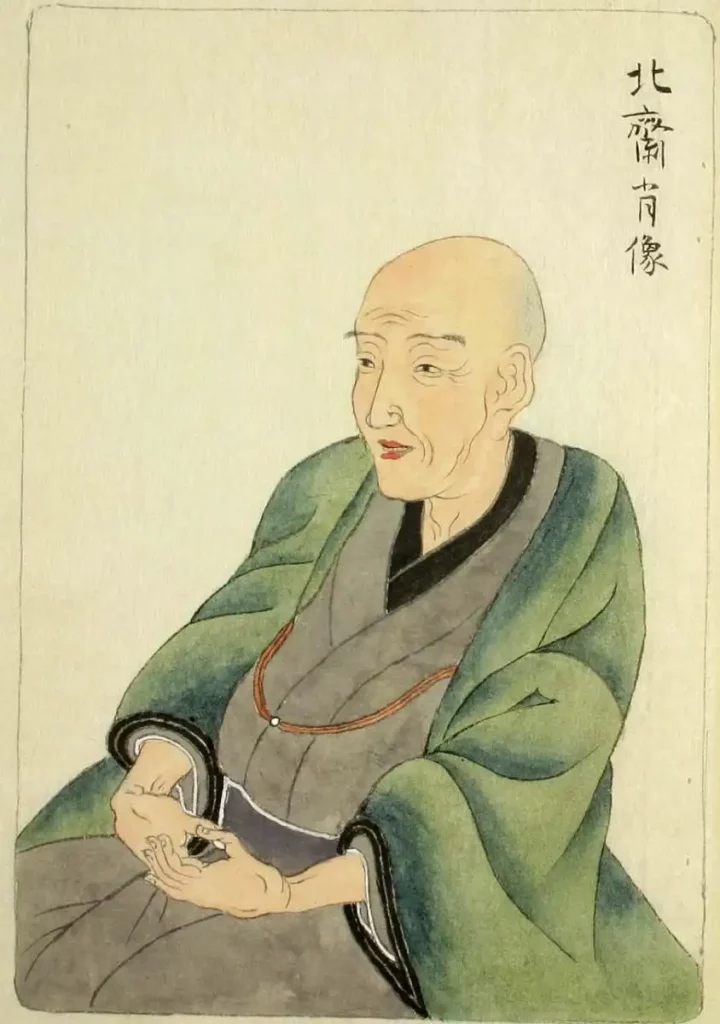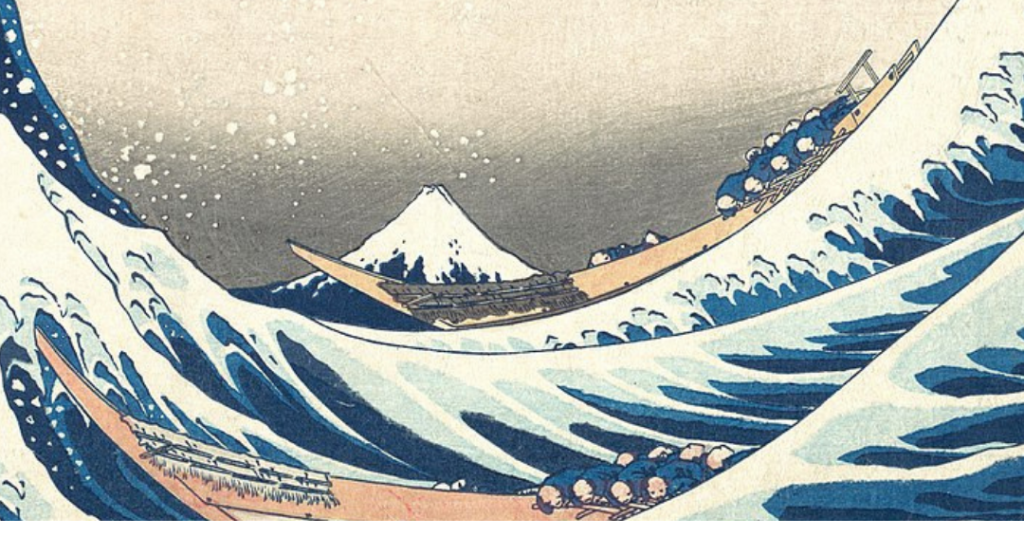In the vast world of art, some art goes beyond mere paintings; they become timeless symbols that speak to people across generations and borders. Katsushika Hokusai’s The Great Wave off Kanagawa is one of those paintings. This Hokusai’s masterpiece was crafted around 1831 as part of the Thirty-Six Views of Mount Fuji series, this woodblock print isn’t just an image; it’s a captivating blend of form and symbolism.
Who Was Katsushika Hokusai

Before we dive into the depths of the Great Wave, let’s take a moment to appreciate the artist behind this masterpiece – Katsushika Hokusai. Born in 1760, Hokusai’s life unfolded during the vibrant Edo period in Japan. He wasn’t just a painter; he was a creative chameleon, constantly reinventing himself with new names and themes.
Hokusai’s artistic brilliance reached its peak during the Edo period. This was a time of cultural flourishing. While his art covered various themes, it was the Thirty-Six Views of Mount Fuji series that elevated him to legendary status. And at the summit of this series stands “The Great Wave off Kanagawa,” a visual poetry capturing nature’s dynamism and Mount Fuji’s enduring strength against a tumultuous wave.
Unveiling the Masterpiece: The Great Wave off Kanagawa

| Artist | Katsushika Hokusai |
| Date Painted | c. 1831 |
| Medium | Woodblock Print |
| Genre | Ukiyo-e |
| Period | Edo |
| Dimensions | 25.7 cm × 37.8 cm (10.1 in × 14.9 in) |
| Series/Versions | From the Thirty-Six Views of Mount Fuji |
| Where is it housed? | The Metropolitan Museum of Art, New York City |
Now, picture the scene – a sweeping panorama where Mount Fuji, a symbol of Japan’s majesty, stands resolute against the onslaught of a colossal wave. This composition isn’t just about visuals; it’s a delicate dance between the everlasting and the ephemeral, capturing the very essence of ukiyo-e – the “floating world.”
The woodblock print, though physically unassuming, unfurls a vast narrative. Its intricate details draw you into a world where nature, symbolism, and cultural nuances intertwine seamlessly. The indigo hues meticulously applied to depict the turbulent sea showcase Hokusai’s mastery of ukiyo-e techniques. The frothy crests of the wave, resembling the claws of a mythical sea creature, reach toward the sky, casting shadows on the vulnerable boats below.
Decoding the Symbolism

Beyond the visual spectacle lies a rich tapestry of symbolism deeply rooted in Japanese culture. Mount Fuji, a steadfast guardian, embodies constancy amidst change. Its snow-capped peak, a beacon of tranquility, provides a stark contrast to the ferocity of the surrounding sea. The tumultuous wave becomes a metaphor for life’s unpredictability, demanding respect and resilience.
But this composition isn’t just an aesthetically pleasing arrangement of elements. It’s a harmonious blend of cultural motifs. The three boats navigating the treacherous waters symbolize the interdependence of humanity and nature. Each boat maneuvers with distinct determination – a subtle commentary on the resilience of the human spirit when faced with the challenges of the unknown.
Hokusai’s brush weaves these elements into a harmonious narrative, creating a timeless visual poem. The rhythmic dance of the wave, the stoic presence of Mount Fuji, and the delicate interplay of light and shadow speak to a profound understanding of nature’s ebb and flow.
Influence and Legacy
“The Great Wave off Kanagawa” isn’t just a print; it’s a cultural symbol that has transcended time and borders. Its influence reaches far beyond Japan, leaving an indelible mark on Western art and captivating luminaries like Monet and Degas. In today’s era, it graces everything from walls and fashion runways to digital platforms, resonating as a global symbol.
Hokusai’s depiction of nature’s inexorable power resonated with Western artists during the 19th-century Japonisme movement. The innovative use of perspective, the dynamic depiction of movement, and the emphasis on the sublime found echoes in the works of European Impressionists. Monet, in particular, admired Hokusai’s ability to capture the essence of a fleeting moment and incorporated similar themes in his iconic series, including “Water Lilies.”
The print’s influence isn’t confined to the fine arts; it has permeated popular culture. Its distinctive aesthetic appears on everything from t-shirts to tattoos. The timeless appeal lies in its ability to evoke universal themes – the beauty and power of nature, the human spirit confronting adversity, and the interplay between the ephemeral and the eternal.
The Great Wave’s Global Resonance
In the contemporary landscape, Hokusai’s wave has transcended its original context, becoming a global symbol. Reproductions adorn walls, fashion runways, and even digital platforms, resonating with a diverse audience. Its intricate details, from the delicate play of colors to the dramatic silhouette of Mount Fuji, continue to captivate art enthusiasts and casual admirers alike.
The print’s enduring popularity speaks to its ability to communicate across cultural and temporal boundaries. Its universal themes make it a canvas onto which viewers project their own interpretations and emotions. Whether displayed in a museum or adorning everyday objects, “The Great Wave off Kanagawa” continues to invite contemplation and spark conversations.
Frequently Asked Questions
Why is The Great Wave off Kanagawa so famous?
The Great Wave’s popularity in Japan was aided by the fact that it was published in a novel and exotic color that had not before been used in Japanese printing. Since we now know it as the Prussian or Berlin blue, it had a distinctly saturated tint. The color was synthetic, and was clearly imported from Europe.
What is the main idea of The Great Wave?
It is preferable to think of the Great Wave as a massive, rogue wave, or possibly as a fabled occurrence, a “yarn” that mariners tell of. The boats appear to be traveling in the direction of the waves, which is in line with the location of Mount Fuji.
Conclusion
As we conclude our voyage through Hokusai’s masterpiece, we find ourselves not just admiring art but experiencing a timeless narrative. “The Great Wave off Kanagawa” isn’t confined to a wooden block; it’s a living testament to an artist’s ability to encapsulate the sublime. With each surge, it carries the spirit of Hokusai – a maestro who dared to capture the torrential beauty of the world in a single frame.
The woodblock print transcends its physical dimensions, inviting us to ride the crest of time and immerse ourselves in the eternal dance between nature and humanity. In its undulating waves and towering peak, we find not just an artwork but a portal into the boundless realm of creativity and cultural exchange. Hokusai’s Great Wave continues to ripple through the currents of artistic inspiration, inviting us to join the voyage and explore the depths of its enduring beauty.













